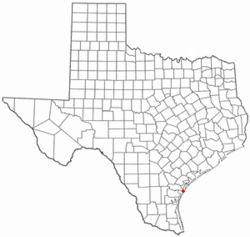Port Aransas, TX
| Port Aransas, Texas | |
|---|---|
| City | |

Boat dock at Port Aransas.
|
|
| Nickname(s): Port A | |
| Motto: Always in Season | |
 Location of Port Aransas, Texas |
|
| Coordinates: 27°50′N 97°4′W / 27.833°N 97.067°WCoordinates: 27°50′N 97°4′W / 27.833°N 97.067°W | |
| Country | United States |
| State | Texas |
| County | Nueces |
| Area | |
| • Total | 12.1 sq mi (31.3 km2) |
| • Land | 8.8 sq mi (22.8 km2) |
| • Water | 3.3 sq mi (8.5 km2) |
| Elevation | 7 ft (2 m) |
| Population (2010) | |
| • Total | 3,480 |
| • Density | 290/sq mi (110/km2) |
| Time zone | Central (CST) (UTC-6) |
| • Summer (DST) | CDT (UTC-5) |
| ZIP code | 78373 |
| Area code(s) | 361 |
| FIPS code | 48-58808 |
| GNIS feature ID | 1344363 |
| Website | http://www.cityofportaransas.org/ |
Port Aransas (/əˈrænzᵻs/ ə-RAN-ziss) is a city in Nueces County, Texas. This city is one hundred and eighty miles southeast of San Antonio. The population was 3,480 at the 2010 census. Port Aransas is the only established town on Mustang Island. It is located north of Padre Island and is one of the longest barrier islands along the Texas coast. Corpus Christi Bay, the Gulf of Mexico, the Lydia Ann Ship Channel and the Corpus Christi Ship Channel make up the surrounding waters.
Karankawa Indians played a key role in the early development of the Texas Gulf Coast. The Karankawa Indians inhabited the Gulf Coast of Texas from Galveston Bay all the way to Corpus Christi Bay. The Karankawa Indians led a nomadic existence, migrating from the mainland to the coast. One of the places they lived in on the coast was a small fishing village known as "Sand Point" on what Europeans called "Wild Horse Island", later known as "Mustang Island".
They were living that nomadic existence when Spaniards, led by Alonso Álvarez de Pineda, probed the coast in 1519. Governor Francisco de Garay of Jamaica had commissioned him to explore the Gulf Coast from Florida to Vera Cruz. In the summer of 1519, Piñeda, took a fleet of four ships east to west around the Gulf Coast exploring and mapping five passes along the Texas Coast line, including what is known today as Aransas Pass.
...
Wikipedia
